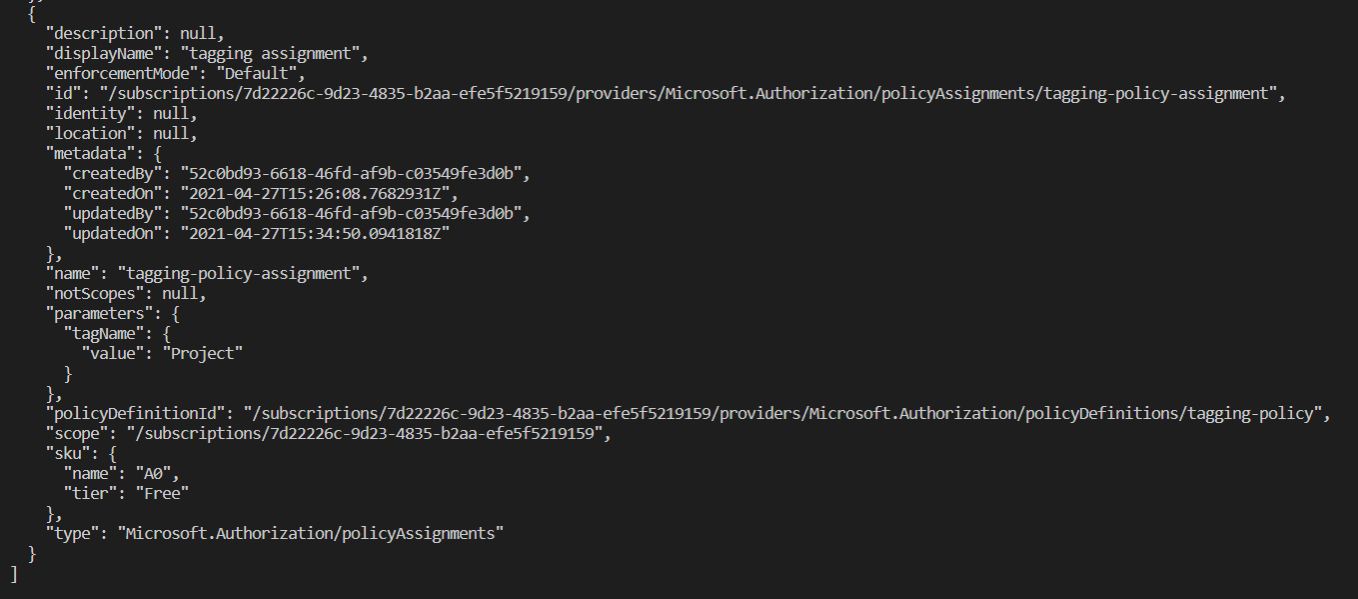In this project, you are going to
- create an Azure Policy,
- build a Packer image, and
- deploy infrastructure to Azure using Terraform.
- Create an Azure Policy
The policy makes it mandatory for indexed resources to have a Project tag. - Build a Packer image
The image contains a linux vm running Ubuntu 18.04-LTS running a "hello world" website. - Deploy infrastructure to Azure using Terraform
This step creates a resource group and the following resources in Azure:- Availability Set
- Data Disks
- OS Disks
- Load Balancer
- Network Interfaces
- Network Security Group
- Public IP Address
- Virtual Machines
- Virtual Network
Ensure that you are logged in to Azure. If not, run:
az login
Create the policy definition:
az policy definition create \
--name tagging-policy \
--display-name "tagging policy for indexed resources" \
--description "indexed resources in this subscription must have tags" \
--rules taggingpolicy.rules.json \
--params taggingpolicy.param.json \
--mode Indexed
Create policy assignment:
az policy assignment create \
--name tagging-policy-assignment \
--display-name "tagging assignment" \
--policy tagging-policy \
--params "{ \"tagName\": {\"value\": \"Project\"} }"
You can also find the commands in taggingpolicy_create_and_assign.azcli.
To see the the policy, you can run
az policy assignment list
Ensure that you are logged in to Azure. If not, run:
az login
Before you can build the Packer template, create a new resource group
az group create -n rg-packer -l westeurope
To grant Packer permission to build templates in Azure, create a service principle
az ad sp create-for-rbac \
--role Contributor \
--query "{ client_id: appId, client_secret: password, tenant_id: tenant }"
In the output of this command, you see a client_id, client_secret and tenant_id. It also shows the sucription id. Take those values and add them to environment_variables.sh. Then run
. environment_variables.sh
Ensure that in server.json, the managed_image_resource_group_name value matches the name of the resource group you just created.
To build the template and create an image in Azure run
packer build server.json
Output:
See the full example output in packer-build.txt
In Azure Portal, you can now see the image.

First, initialize a working directory. Ensure that you run below command in the directory that contains the Terraform configuration files.
terraform init
You can customize the following variables in terraform.tfvars:
- prefix
- The prefix that gets added to all resources
- rgname
- The name of the resource group that the deployment creates
- location
- The Azure region the resource group and the resources get created in.
- username
- The username of the VMs' admin user
- password
- The admin user's password
- vm-count
- The number of VMs that you want to create
- packer_rg
- The name of the resource group you created the Packer image in. It has to match the
managed_image_resource_group_namevalue in server.json
- The name of the resource group you created the Packer image in. It has to match the
- packer_image_name
- The name of the Packer image. It has to match the
managed_image_namevalue in server.json
- The name of the Packer image. It has to match the
- project
- The project name that gets added as a tag to all resources
Create an execution plan.
terraform plan --out solution.plan
Output:
See the full example output in terraform-plan.txt
Apply the actions generated in the previous terraform plan step.
terraform apply "solution.plan"
Output:
See the full example output in terraform-apply.txt
You can see the deployed resources in Azure Portal:

If your resources are no longer needed, run below command to delete the resources and the resource group.
terraform destroy
Once done, you see the output:
Destroy complete! Resources: 23 destroyed.
See the full example output in terraform-destroy.txt



